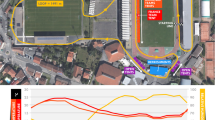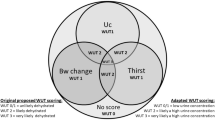Abstract
To determine if athletes’ muscle mass affects the usefulness of urine specific gravity (U sg) as a hydration index. Nine rugby players and nine endurance runners differing in the amount of muscle mass (42 ± 6 vs. 32 ± 3 kg, respectively; P = 0.0002) were recruited. At waking during six consecutive days, urine was collected for U sg analysis, urine osmolality (U osm), electrolytes (\( {\mathop U\nolimits_{[{\text{Na}}^{ + } ]} }\), \( {\mathop U\nolimits_{[{\text{K}}^{ + } ]} }\) and \( {\mathop U\nolimits_{[{\text{Cl}}^{ - } ]} }\)) and protein metabolites (U [Creatinine], U [Urea] and U [Uric acid]) concentrations. In addition, fasting blood serum osmolality (S osm) was measured on the sixth day. As averaged during 6 days, U sg (1.021 ± 0.002 vs. 1.016 ± 0.001), U osm (702 ± 56 vs. 554 ± 41 mOsmol kg−1 H2O), U [Urea] (405 ± 36 vs. 302 ± 23 mmol L−1) and U [Uric acid] (2.7 ± 0.3 vs. 1.7 ± 0.2 mmol L−1) were higher in rugby players than runners (P < 0.05). However, urine electrolyte concentrations were not different between groups. A higher percentage of rugby players than runners (56 vs. 11%; P = 0.03) could be cataloged as hypohydrated by U sg (i.e., >1.020) despite S osm being below 290 mOsmol kg−1 H2O in all participants. A positive correlation was found between muscle mass and urine protein metabolites (r = 0.47; P = 0.04) and between urine protein metabolites and U sg (r = 0.92; P < 0.0001). In summary, U sg specificity to detect hypohydration was reduced in athletes with large muscle mass. Our data suggest that athletes with large muscle mass (i.e., rugby players) are prone to be incorrectly classified as hypohydrated based on U sg.


Similar content being viewed by others
References
Armstrong LE (2005) Hydration assessment techniques. Nutr Rev 63:S40–S54
Armstrong LE, Maresh CM, Castellani JW et al (1994) Urinary indices of hydration status. Int J Sport Nutr 4:265–279
Armstrong LE, Soto JA, Hacker FTJ et al (1998) Urinary indices during dehydration, exercise, and rehydration. Int J Sport Nutr 8:345–355
Atkinson G, Nevill AM (1998) Statistical methods for assessing measurement error (reliability) in variables relevant to sports medicine. Sports Med 26:217–238
Baker LB, Lang JA, Kenney WL (2009) Change in body mass accurately and reliably predicts change in body water after endurance exercise. Eur J Appl Physiol 105:959–967
Bartok C, Schoeller DA, Sullivan JC et al (2004) Hydration testing in collegiate wrestlers undergoing hypertonic dehydration. Med Sci Sports Exerc 36:510–517
Baxmann AC, Ahmed MS, Marques NC et al (2008) Influence of muscle mass and physical activity on serum and urinary creatinine and serum cystatin C. Clin J Am Soc Nephrol 3:348–354
Carter JEL (1982) Anthropometric instruments and measurements used in the Montreal Olympic Games Anthropological Project. In: Carter JEL (Ed) Physical structure of Olympic athletes. Part I: medicine and sport science. Karger, Basel
Casa DJ, Armstrong LE, Hillman SK et al (2000) National athletic trainers’ association position statement: fluid replacement for athletes. J Athl Train 35:212–224
Cheuvront SN, Carter RIII, Montain SJ et al (2004) Daily body mass variability and stability in active men undergoing exercise-heat stress. Int J Sport Nutr Exerc Metab 14:532–540
Committee NWR (1998–1999) Wrestling weight certification program. NCAA, Indianapolis
Consolazio FC, Johnson RE, Pecora LJ (1963) Physiological variability in young men. In: Physiological measurements of metabolic functions in man. McGraw-Hill, New York, pp 453–478
Dubois D, Dubois EF (1916) A formula to estimate the approximate surface area if height and weight be known. Arch Int Med 17:863–871
Godek SF, Bartolozzi AR, Godek JJ (2005) Sweat rate and fluid turnover in American football players compared with runners in a hot and humid environment. Br J Sports Med 39:205–211
Guyton AC, Hall JE (2006) Textbook of medical physiology. Elsevier Saunders, Philadelphia
Heymsfield SB, Arteaga C, McManus C et al (1983) Measurement of muscle mass in humans: validity of the 24-h urinary creatinine method. Am J Clin Nutr 37:478–494
Koutedakis Y (1995) Seasonal variation in fitness parameters in competitive athletes. Sports Med 19:373–392
Martin WF, Cerundolo LH, Pikosky MA et al (2006) Effects of dietary protein intake on indexes of hydration. J Am Diet Assoc 106:587–589
Maughan RJ, Shirreffs SM, Leiper JB (2007) Errors in the estimation of hydration status from changes in body mass. J Sports Sci 25:797–804
Oppliger RA, Bartok C (2002) Hydration testing of athletes. Sports Med 32:959–971
Oppliger RA, Magnes SA, Popowski LA et al (2005) Accuracy of urine specific gravity and osmolality as indicators of hydration status. Int J Sport Nutr Exerc Metab 15:236–251
Popowski LA, Oppliger RA, Patrick Lambert G et al (2001) Blood and urinary measures of hydration status during progressive acute dehydration. Med Sci Sports Exerc 33:747–753
Robertson GL, Aycinena P, Zerbe RL (1982) Neurogenic disorders of osmoregulation. Am J Med 72:339–353
Sawka MN, Burke LM, Eichner ER et al (2007) American College of Sports Medicine position stand. Exercise and fluid replacement. Med Sci Sports Exerc 39:377–390
Senay LC (1979) Temperature regulation and hypohydration: a singular view. J Appl Physiol 47:1–7
Shirreffs SM, Maughan RJ (1998) Urine osmolality and conductivity as indices of hydration status in athletes in the heat. Med Sci Sports Exerc 30:1598–1602
Stover EA, Petrie HJ, Passe D et al (2006) Urine specific gravity in exercisers prior to physical training. Appl Physiol Nutr Metab 31:320–327
Traynor J, Mactier R, Geddes CC et al (2006) How to measure renal function in clinical practice. BMJ 333:733–737
Vincent WJ (1999) Statistics in kinesiology. Human Kinetics, Champaign
Acknowledgments
The authors wish to thank the participants for their invaluable contribution to the study. Nassim Hamouti and Juan Del Coso were supported by a predoctoral fellowship from the Castilla-La Mancha government in Spain. Andrea Ávila was supported by a Latin-American grant from the Gatorade Sport Science Institute.
The authors of this study declare that the experiments comply with the current laws of the country in which they were performed. The study was approved by the local Hospital Research Ethics Committee and conducted in accordance with the guidelines of the revised Declaration of Helsinki. The assistance of Emma Estevez is greatly appreciated.
Conflict of interest statement
The authors of this study declare that they have no financial, professional or other personal interest of any nature in any product, service and/or company that could be construed as influencing the position presented in this manuscript.
Author information
Authors and Affiliations
Corresponding author
Additional information
Communicated by Nigel Taylor.
Rights and permissions
About this article
Cite this article
Hamouti, N., Coso, J.D., Ávila, A. et al. Effects of athletes’ muscle mass on urinary markers of hydration status. Eur J Appl Physiol 109, 213–219 (2010). https://doi.org/10.1007/s00421-009-1333-x
Accepted:
Published:
Issue Date:
DOI: https://doi.org/10.1007/s00421-009-1333-x




